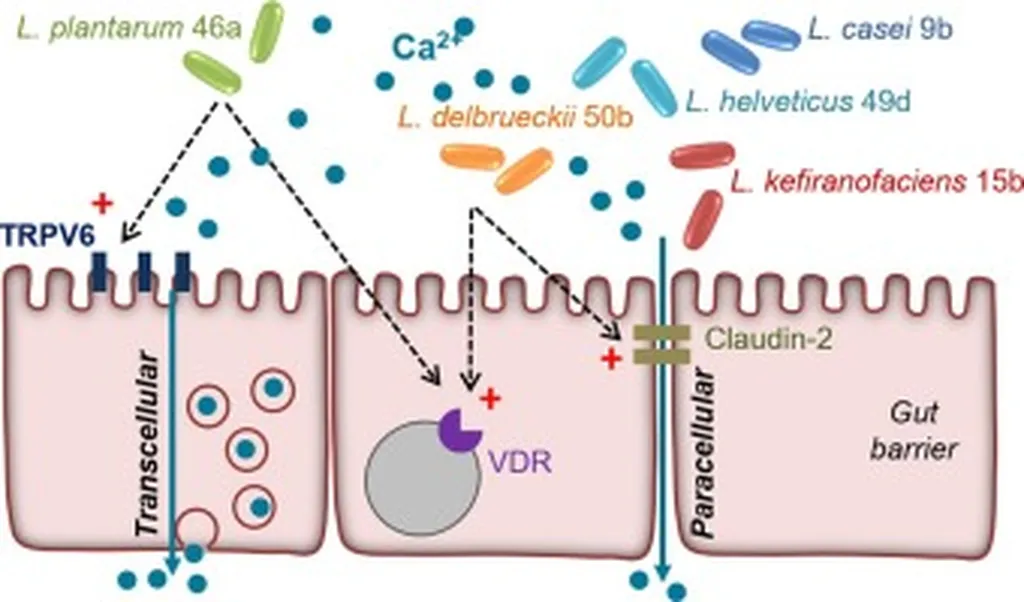In a groundbreaking study published in *Shipin Kexue* (translated to *Journal of Food Science*), researchers from the Key Laboratory of Dairy Biotechnology and Engineering at Inner Mongolia Agricultural University have unveiled the intricate mechanisms by which lactic acid bacteria enhance calcium absorption in the human body. Led by Dr. Ma Zhihe, the research team has identified six key pathways through which these beneficial bacteria promote calcium uptake, offering promising avenues for developing targeted calcium supplements and preventing osteoporosis.
The study highlights that lactic acid bacteria, commonly found in fermented foods like yogurt and kefir, play a pivotal role in improving bone health. “Our findings suggest that lactic acid bacteria can significantly influence calcium absorption through multiple pathways,” said Dr. Ma Zhihe, the lead author of the study. “This opens up new possibilities for developing more effective calcium supplements that leverage the natural benefits of these bacteria.”
One of the primary mechanisms identified involves the increased intestinal absorption of vitamin D, which in turn enhances the transcellular pathway of calcium absorption. Additionally, lactic acid bacteria secrete phytase, an enzyme that increases the concentration of free calcium ions in the intestines. This dual action not only boosts calcium availability but also improves its bioavailability, making it more accessible for absorption.
The research also reveals that lactic acid bacteria metabolize prebiotics to produce short-chain fatty acids, which reduce intestinal pH and increase the surface area of microvilli. This process enhances the signaling pathways involved in mineral absorption, further facilitating calcium uptake. “The production of short-chain fatty acids is a crucial factor in optimizing calcium absorption,” explained Dr. Wang Ruixue, a co-author of the study. “This mechanism underscores the importance of maintaining a healthy gut microbiome for overall bone health.”
Moreover, lactic acid bacteria transform lactose into lactic acid and short-chain fatty acids, which increase the body’s ability to absorb calcium. The production of bioactive substances by these bacteria also raises the content of soluble calcium in the intestinal tract, improving its bioavailability. The study further highlights the role of the gut-bone axis, where lactic acid bacteria directly or indirectly regulate bone metabolism, affecting bone homeostasis.
The implications of this research are far-reaching, particularly in the field of nutritional supplements and bone health. “Understanding these mechanisms allows us to develop more efficient and targeted calcium supplements based on lactic acid bacteria,” said Dr. Wang Junguo, another co-author. “This could revolutionize the way we approach calcium supplementation and osteoporosis prevention.”
The study, published in *Shipin Kexue*, provides a comprehensive review of the mechanisms by which lactic acid bacteria promote calcium absorption, laying the groundwork for future research and commercial applications. As the global population ages, the demand for effective bone health solutions is on the rise. This research offers a promising pathway to meet this need, potentially transforming the nutritional supplement industry and improving the quality of life for millions of people.
The findings not only shed light on the intricate interplay between gut health and bone metabolism but also pave the way for innovative dietary interventions. By harnessing the power of lactic acid bacteria, researchers and commercial entities can develop products that enhance calcium absorption and promote bone health, addressing a critical public health concern. As the scientific community continues to explore these mechanisms, the potential for groundbreaking advancements in the field of nutrition and bone health is immense.

